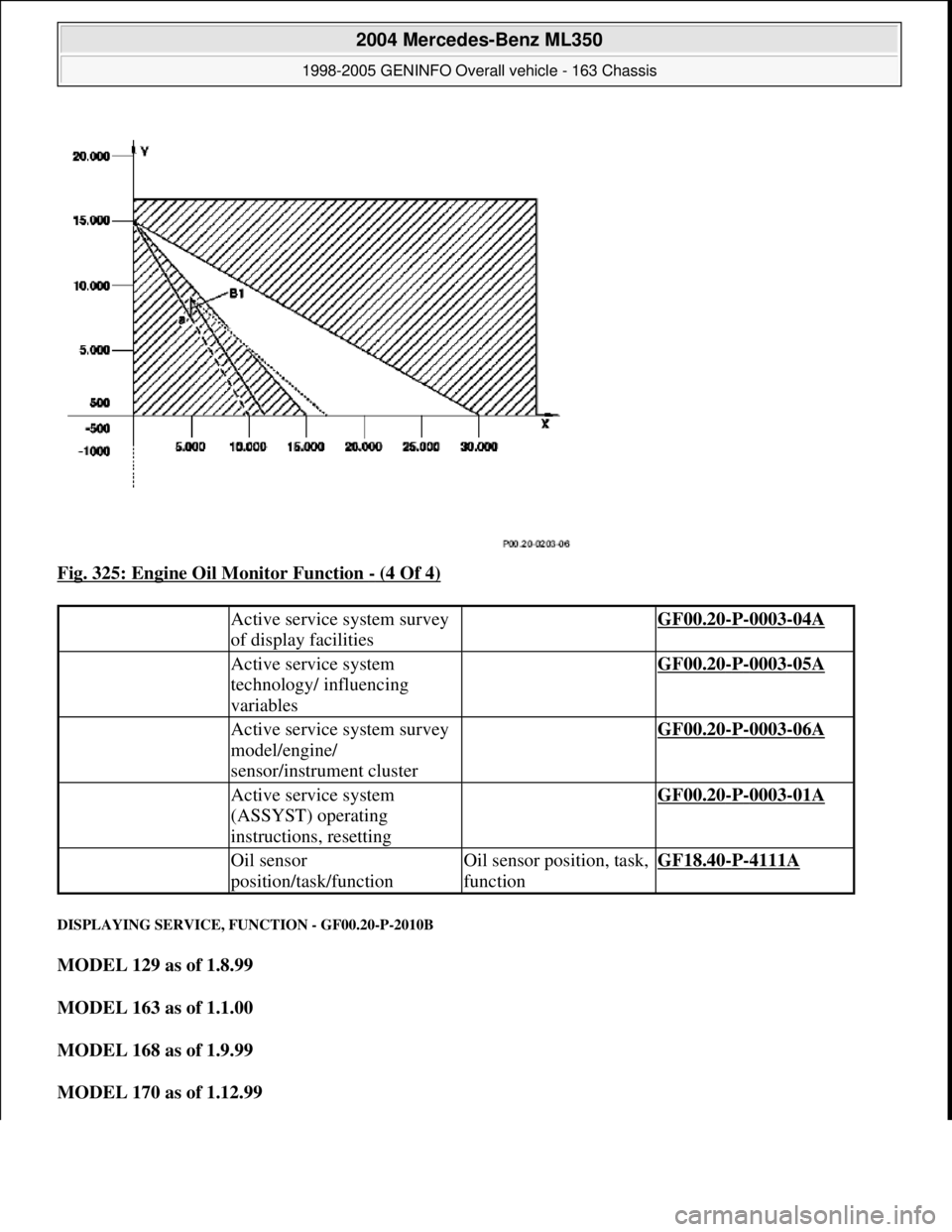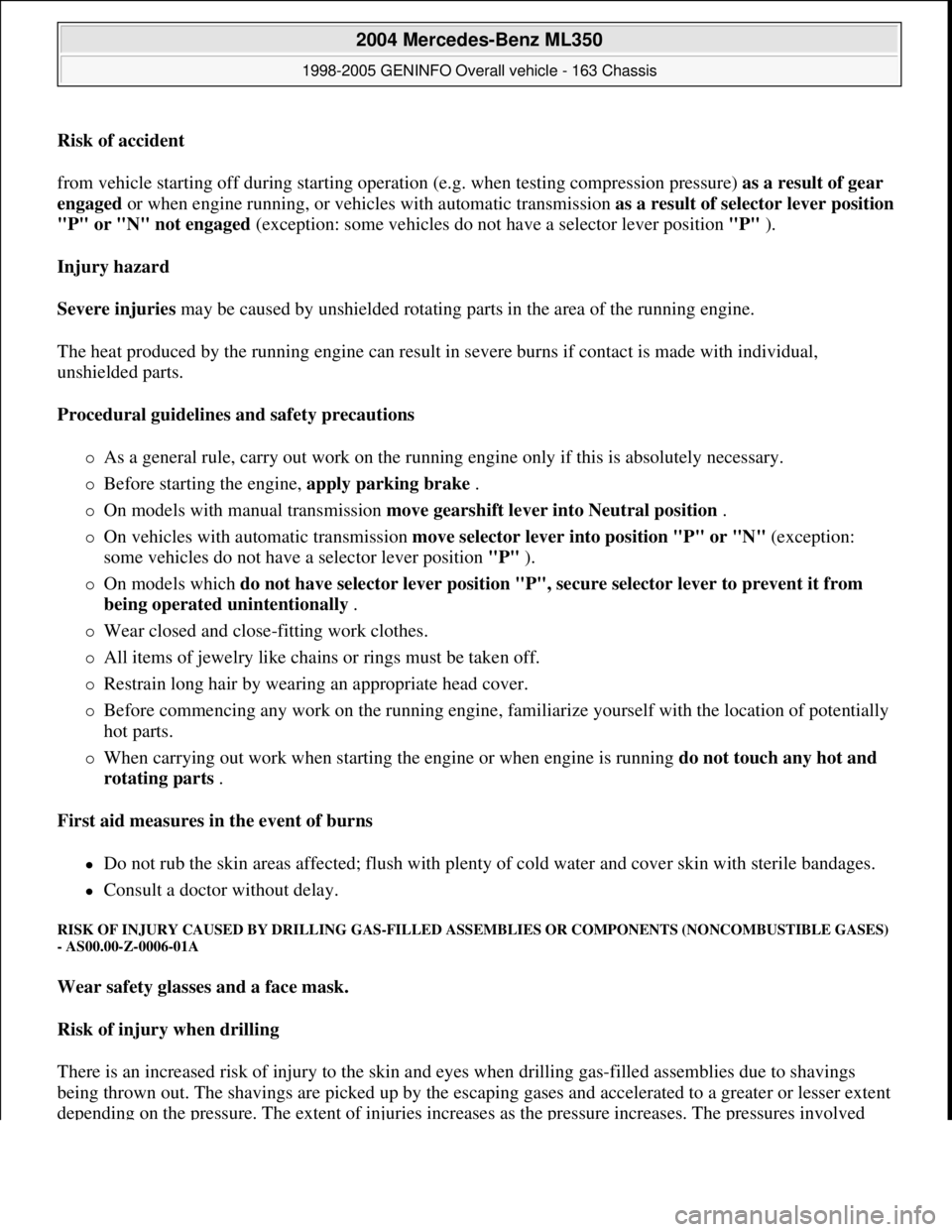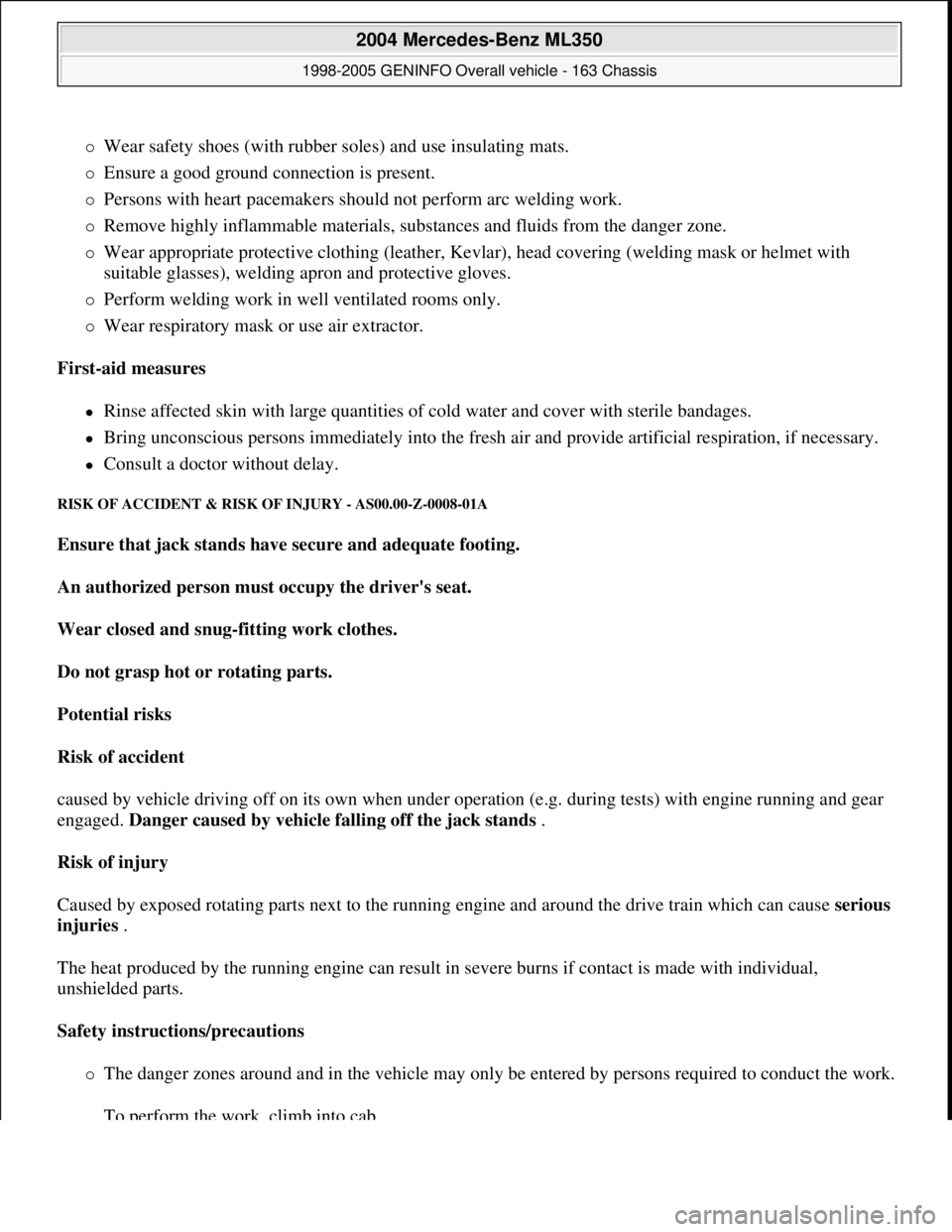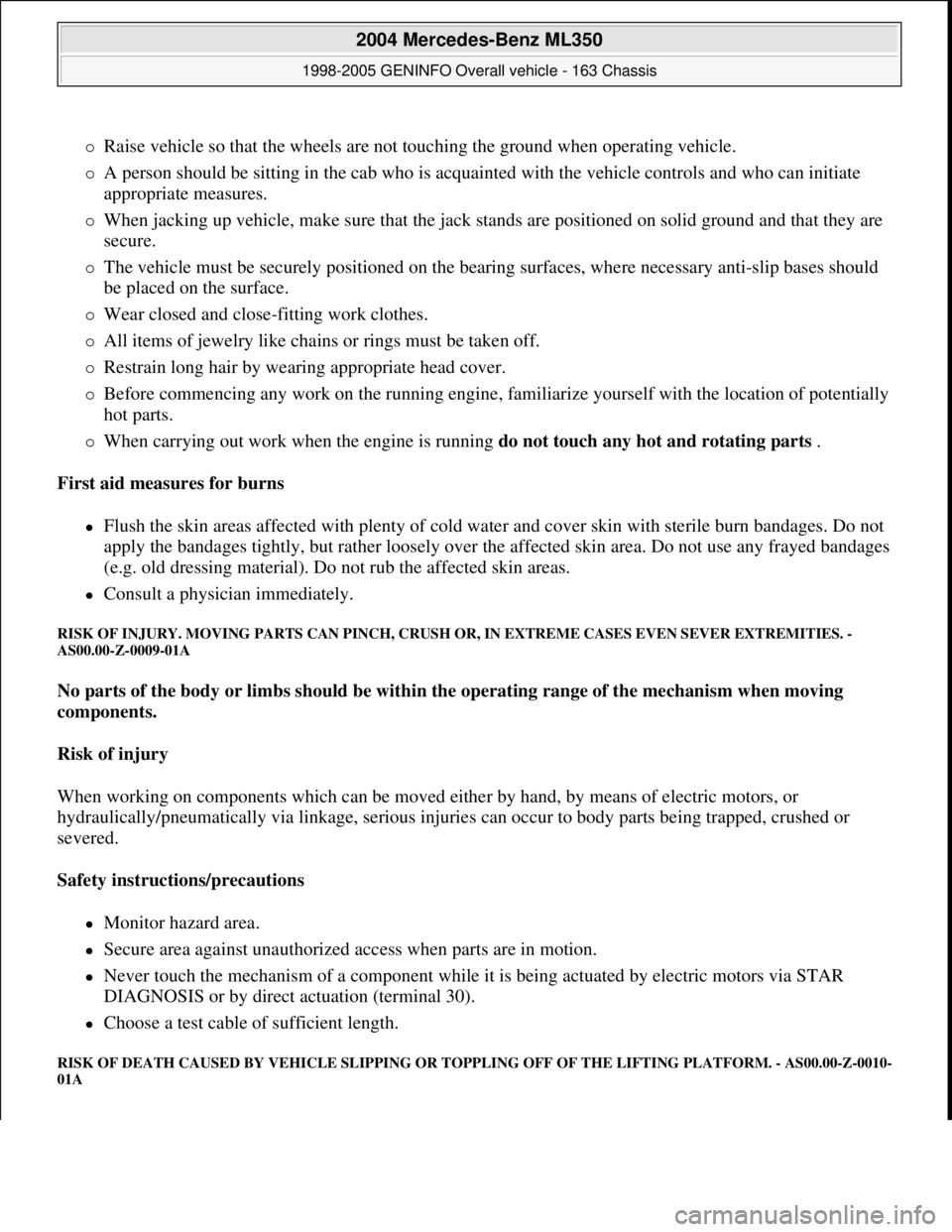1997 MERCEDES-BENZ ML320 engine
[x] Cancel search: enginePage 2857 of 4133

In the charts overleaf, a number of examples of this are presented. The horizontal (x) axis represents the service
interval and the vertical (y) axis is the remaining distance in each case in km.
conditions are met:
the replenished quantity is at least 1 l
after replenishing the oil, the car must be driven a distance of at least 5 km under normal driving
conditions at an oil temperature of at least 60°C
There are instances, however, in which the readout of the remaining distance nevertheless appears implausible
after replenishing oil; according to the display, no bonus or only a small bonus has been issued. This is caused
by the fact that the remaining distance is always only displayed within a range from 15 000 km up to 30 000 km
(or 20 000 km up to 40 000 km in the case of engine 668), but internally the system calculates with the actual
values which may also be beyond this range. These internal values can only be displayed with the HHT.
horizontal (x) axis represents the service interval and the vertical (y) axis is the remaining distance in each case
in km.
The readout of ASSYST in the instrument cluster always moves within the light range.
The remaining distance calculated internally may also, however, be within the two dark ranges. These internal
values can only be displayed with the HHT.
All examples relate to gasoline engines fitted with an oil sensor.
Example 1 :
Sufficient oil was added during the oil change. This means that the starting distance is 15 000 km.
After 10 000 km oil is topped up under normal driving conditions (a). The bonus (B1) is issued and displayed.
What this means is that when the remaining distance is retrieved, a greater remaining distance is displayed.
(Provided the aforementioned conditions for detecting the oil replenishment are met.)
Oil is topped up again after a further 5 000 km (b). In this case also a bonus (B2) is issued and displayed.
If, after this, no further oil is topped up and the car continues to be driven in the same manner, a service interval
of about 24 000 km is thus achieved.
In this example, the curve moves at all points within the light range of the chart; consequently, all the oil
replenishments are displayed by increasing the remaining distance.
2004 Mercedes-Benz ML350
1998-2005 GENINFO Overall vehicle - 163 Chassis
me
Saturday, October 02, 2010 3:47:47 PMPage 212 © 2006 Mitchell Repair Information Company, LLC.
Page 2858 of 4133

Fig. 322: Engine Oil Monitor Function - (1 Of 4)
Example 2:
The specified quantity of oil was added when the oil was changed.
The car is driven under very favorable conditions and oil is topped up after 10 000 km (a). Internally, the bonus
B1 is issued, the service interval is extended accordi ngly by enlarging the remaining distance. However, as the
curve is sometimes within the shaded ar ea, only the part of B1 which is within the light area, is at first displayed
as an extension of the remaining distance. (Provi ded the aforementioned conditions for detecting oil
replenishment are met.)
Oil is topped up once again at 18 000 km (b ). In view of the fact that the maximum service interval of 30 000
km was exceeded, the bonus B2 is not initially displayed as an extension. Th e entire service interval in this case
is 30 000 km.
If, from point b, the car continues to be driven under less favorable conditions , it may still also be possible now
to achieve the maximum service interval of 30 000 km because of the internal bonus B2.
Fig. 323: Engine Oil Monitor Function
- (2 Of 4)
Example 3:
When the oil was changed, the quantity added was less than the specified quantity. Consequently, the start
distance is less than 15 000 km.
2004 Mercedes-Benz ML350
1998-2005 GENINFO Overall vehicle - 163 Chassis
me
Saturday, October 02, 2010 3:47:47 PMPage 213 © 2006 Mitchell Repair Information Company, LLC.
Page 2859 of 4133

If oil is now topped up after 5 000 km (a), the remaining distance displayed is not extended as the curve is
within the shaded area. The bonus B1 is nevertheless added internally and results in an extension of the service
interval to slightly more than 15 000 km - provided the driving conditions remain the same or are more
favorable.
(The service interval of 15 000 km is always reached, however, even if the internal value were less.)
Fig. 324: Engine Oil Monitor Function
- (3 Of 4)
Example 4:
Oil has been topped up after 5 000 km under unfavorable driving conditions (a) and the oil replenishment
(bonus B1) detected internally. We now have two cases to consider:
If the car continues to be driven under the same conditions (unbroken line), the remaining distance
displayed is not extended as the curve is within the shaded area.
The service interval in this case is nevertheless 15 000 km although the internal value is less. (The
remaining distance displayed can always only be within the light area.)
If the car continues to be operated under more favorable conditions (broken line), the value of the internal
remaining distance slowly moves into the light area. Consequently, the service interval may be greater
than 15 000 km.
2004 Mercedes-Benz ML350
1998-2005 GENINFO Overall vehicle - 163 Chassis
me
Saturday, October 02, 2010 3:47:47 PMPage 214 © 2006 Mitchell Repair Information Company, LLC.
Page 2860 of 4133

Fig. 325: Engine Oil Monitor Function - (4 Of 4)
DISPLAYING SERVICE, FUNCTION - GF00.20-P-2010B
MODEL 129 as of 1.8.99
MODEL 163 as of 1.1.00
MODEL 168 as of 1.9.99
MODEL 170 as of 1.12.99
Active service system survey
of display facilities GF00.20-P-0003-04A
Active service system
technology/ influencing
variables GF00.20-P-0003-05A
Active service system survey
model/engine/
sensor/instrument cluster GF00.20-P-0003-06A
Active service system
(ASSYST) operating
instructions, resetting GF00.20-P-0003-01A
Oil sensor
position/task/functionOil sensor position, task,
functionGF18.40-P-4111A
2004 Mercedes-Benz ML350
1998-2005 GENINFO Overall vehicle - 163 Chassis
me
Saturday, October 02, 2010 3:47:47 PMPage 215 © 2006 Mitchell Repair Information Company, LLC.
Page 2863 of 4133

Safety precautions/instructions
Wear protective clothing, safety glasses and heat-resistant gloves.
Transport hot or glowing objects using approved equipment only.
When handling glowing objects, avoid sparks and keep objects away from flammable materials and
substances.
First aid measures
Flush the affected skin areas with plenty of cold water and dress with sterile bandages.
Consult a doctor without delay.
RISK OF DEATH. DEATH MAY OCCUR IF BODY PARTS ARE DRAWN INTO ROTATING VEHICLE PARTS. - AS00.00-Z-
0004-01A
Do not reach into rotating parts.
Wear closed and snug-fitting work clothes.
Secure area near rotating vehicle parts against unauthorized access.
Risk of death
Freely rotating parts near the running engine and around the drive train can cause serious injuries .
During all work on rotating driven axles the opposite wheel hub spins in rotation as well. This produces a blind
hazard area that must be protected from unauthorized access.
Safety instructions/precautions
Wear closed and snug-fitting work clothes.
Remove all items of jewelry, such as chains, rings, etc.
Restrain long hair by wearing an appropriate head cover.
Set up appropriate shielding (e.g. barrier, safety guard) to secure blind hazard areas against unauthorized
access.
RISK OF ACCIDENT & RISK OF INJURY - AS00.00-Z-0005-01A
Secure vehicle to prevent it from moving off by itself.
Wear closed and close-fitting work clothes.
Do not grasp hot or rotating parts.
Possible hazards
2004 Mercedes-Benz ML350
1998-2005 GENINFO Overall vehicle - 163 Chassis
me
Saturday, October 02, 2010 3:47:47 PMPage 218 © 2006 Mitchell Repair Information Company, LLC.
Page 2864 of 4133

Risk of accident
from vehicle starting off during starting operation (e.g. when testing compression pressure) as a result of gear
engaged or when engine running, or vehicles with automatic transmission as a result of selector lever position
"P" or "N" not engaged (exception: some vehicles do not have a selector lever position "P" ).
Injury hazard
Severe injuries may be caused by unshielded rotating parts in the area of the running engine.
The heat produced by the running engine can result in severe burns if contact is made with individual,
unshielded parts.
Procedural guidelines and safety precautions
As a general rule, carry out work on the running engine only if this is absolutely necessary.
Before starting the engine, apply parking brake .
On models with manual transmission move gearshift lever into Neutral position .
On vehicles with automatic transmission move selector lever into position "P" or "N" (exception:
some vehicles do not have a selector lever position "P" ).
On models which do not have selector lever position "P", secure selector lever to prevent it from
being operated unintentionally .
Wear closed and close-fitting work clothes.
All items of jewelry like chains or rings must be taken off.
Restrain long hair by wearing an appropriate head cover.
Before commencing any work on the running engine, familiarize yourself with the location of potentially
hot parts.
When carrying out work when starting the engine or when engine is running do not touch any hot and
rotating parts .
First aid measures in the event of burns
Do not rub the skin areas affected; flush with plenty of cold water and cover skin with sterile bandages.
Consult a doctor without delay.
RISK OF INJURY CAUSED BY DRILLING GAS-FILLED ASSEMBLIES OR COMPONENTS (NONCOMBUSTIBLE GASES)
- AS00.00-Z-0006-01A
Wear safety glasses and a face mask.
Risk of injury when drilling
There is an increased risk of injury to the skin and eyes when drilling gas-filled assemblies due to shavings
being thrown out. The shavings are picked up by the escaping gases and accelerated to a greater or lesser extent
depending on the pressure. The extent of injuries increases as the pressure increases. The pressures involved
2004 Mercedes-Benz ML350
1998-2005 GENINFO Overall vehicle - 163 Chassis
me
Saturday, October 02, 2010 3:47:47 PMPage 219 © 2006 Mitchell Repair Information Company, LLC.
Page 2866 of 4133

Wear safety shoes (with rubber soles) and use insulating mats.
Ensure a good ground connection is present.
Persons with heart pacemakers should not perform arc welding work.
Remove highly inflammable materials, substances and fluids from the danger zone.
Wear appropriate protective clothing (leather, Kevlar), head covering (welding mask or helmet with
suitable glasses), welding apron and protective gloves.
Perform welding work in well ventilated rooms only.
Wear respiratory mask or use air extractor.
First-aid measures
Rinse affected skin with large quantities of cold water and cover with sterile bandages.
Bring unconscious persons immediately into the fresh air and provide artificial respiration, if necessary.
Consult a doctor without delay.
RISK OF ACCIDENT & RISK OF INJURY - AS00.00-Z-0008-01A
Ensure that jack stands have secure and adequate footing.
An authorized person must occupy the driver's seat.
Wear closed and snug-fitting work clothes.
Do not grasp hot or rotating parts.
Potential risks
Risk of accident
caused by vehicle driving off on its own when under operation (e.g. during tests) with engine running and gear
engaged. Danger caused by vehicle falling off the jack stands .
Risk of injury
Caused by exposed rotating parts next to the running engine and around the drive train which can cause serious
injuries .
The heat produced by the running engine can result in severe burns if contact is made with individual,
unshielded parts.
Safety instructions/precautions
The danger zones around and in the vehicle may only be entered by persons required to conduct the work.
To perform the work, climb into cab.
2004 Mercedes-Benz ML350
1998-2005 GENINFO Overall vehicle - 163 Chassis
me
Saturday, October 02, 2010 3:47:47 PMPage 221 © 2006 Mitchell Repair Information Company, LLC.
Page 2867 of 4133

Raise vehicle so that the wheels are not touching the ground when operating vehicle.
A person should be sitting in the cab who is acquainted with the vehicle controls and who can initiate
appropriate measures.
When jacking up vehicle, make sure that the jack stands are positioned on solid ground and that they are
secure.
The vehicle must be securely positioned on the bearing surfaces, where necessary anti-slip bases should
be placed on the surface.
Wear closed and close-fitting work clothes.
All items of jewelry like chains or rings must be taken off.
Restrain long hair by wearing appropriate head cover.
Before commencing any work on the running engine, familiarize yourself with the location of potentially
hot parts.
When carrying out work when the engine is running do not touch any hot and rotating parts .
First aid measures for burns
Flush the skin areas affected with plenty of cold water and cover skin with sterile burn bandages. Do not
apply the bandages tightly, but rather loosely over the affected skin area. Do not use any frayed bandages
(e.g. old dressing material). Do not rub the affected skin areas.
Consult a physician immediately.
RISK OF INJURY. MOVING PARTS CAN PINCH, CRUSH OR, IN EXTREME CASES EVEN SEVER EXTREMITIES. -
AS00.00-Z-0009-01A
No parts of the body or limbs should be within the operating range of the mechanism when moving
components.
Risk of injury
When working on components which can be moved either by hand, by means of electric motors, or
hydraulically/pneumatically via linkage, serious injuries can occur to body parts being trapped, crushed or
severed.
Safety instructions/precautions
Monitor hazard area.
Secure area against unauthorized access when parts are in motion.
Never touch the mechanism of a component while it is being actuated by electric motors via STAR
DIAGNOSIS or by direct actuation (terminal 30).
Choose a test cable of sufficient length.
RISK OF DEATH CAUSED BY VEHICLE SLIPPING OR TOPPLING OFF OF THE LIFTING PLATFORM. - AS00.00-Z-0010-
01A
2004 Mercedes-Benz ML350
1998-2005 GENINFO Overall vehicle - 163 Chassis
me
Saturday, October 02, 2010 3:47:47 PMPage 222 © 2006 Mitchell Repair Information Company, LLC.